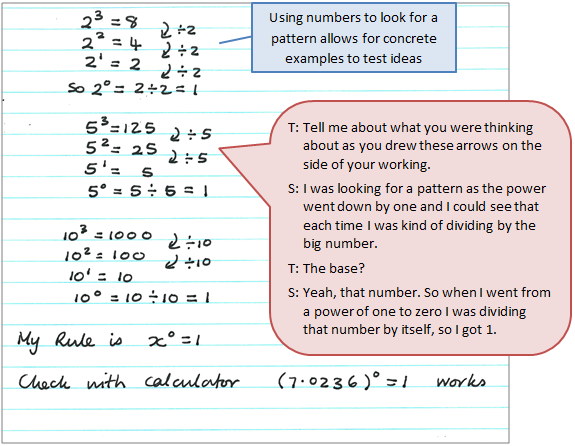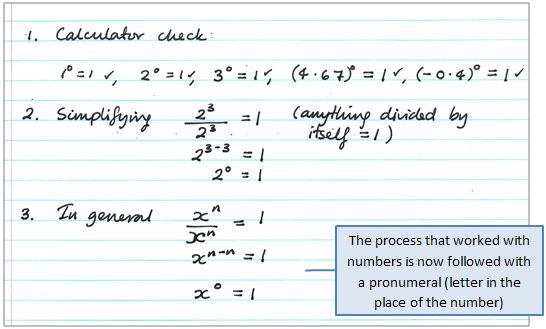The purpose of this activity is to engage students in using deductive reasoning to justify an index rule.
This activity assumes the students have experience in the following areas:
- Working with indices, including whole number powers of whole numbers.
- Continuing and representing sequential patterns.
- Multiplying and dividing powers with the same base.
The problem is sufficiently open ended to allow the students freedom of choice in their approach. It may be scaffolded with guidance that leads to a solution, and/or the students might be given the opportunity to solve the problem independently.
The example responses at the end of the resource give an indication of the kind of response to expect from students who approach the problem in particular ways.
Task: Use the index rules you know, to show how you can say that
x0 = 1
The following prompts illustrate how this activity can be structured around the phases of the Mathematics Investigation Cycle.
Make sense
Introduce the problem. Allow students time to read it and discuss in pairs or small groups.
- What are the important words and symbols? (Students need to understand the meaning of powers expressed in exponent notation, e.g., 34 = 3 Х 3 Х 3 Х 3.)
- What would be good examples to try? (That involves replacing x with different whole numbers.)
- What do I already know that will be needed to solve this problem? (Students may already know properties of whole numbers under the operations, such as inverse and identity.)
Plan approach
Discuss ideas about how to solve the problem. Emphasise that, in the planning phase, you want students to say how they would solve the problem, not to actually solve it.
- What are the maths skills I need to work this out? (Multiplication and division are required to make sense of the patterns generated by powers.)
- What could the solution look like? (The problem demands a justification, not just a set of calculations.)
- What strategies can I use to get started? (Listing examples in an ordered list is an important first step.)
- Can I notice a pattern to write down and explore?
- What simple numbers, for the base, could I try first?
- What tools (digital or physical) could help my investigation? (Digital calculation will save time and ease load on working memory.)
Take action
Allow students time to work through their strategy and find a solution to the problem.
- Have I created enough examples to find a common property among the differences?
- Have I recorded my ideas in a way that helps me to see patterns?
- Are there any patterns?
- How might I describe the pattern?
- What is the best way to express the patterns I see? (Algebra is important to this task. Letters can be used as generalised numbers, e.g., X used to represent any base.)
Convince yourself and others
Allow students time to check their answers and then either have them pair share with other groups or ask for volunteers to share their solution with the class.
- What is the solution?
- Show and explain how you worked out your solution.
- How does my solution answer the question? (How does your solution justify why X0 = 1?)
- What connections can I see to other situations, why would this be? (Could students extend their reasoning to deal with negative exponents?)
- Can I get beyond examples and use the properties of exponents? (See conceptual example.)
- Which ideas would convince others that my findings answer the investigation question?
Examples of work
Work sample 1
The student finds a pattern that leads to justifying the rule, using several examples with different bases.
Click on the image to enlarge it. Click again to close.
Work sample 2
The student justifies the rule, using concrete examples and then generalising.
Click on the image to enlarge it. Click again to close.
Work sample 3
The student justifies the rule by generalising using properties of operations.


